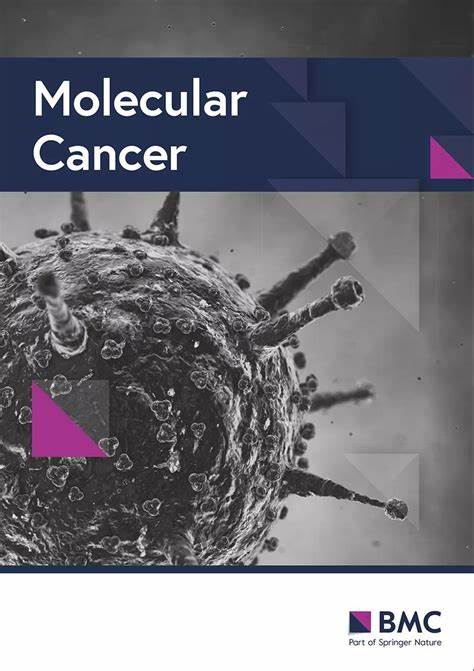生物靶向双适应性和先天纳米免疫治疗透明细胞肾细胞癌
IF 33.9
1区 医学
Q1 BIOCHEMISTRY & MOLECULAR BIOLOGY
引用次数: 0
摘要
免疫疗法显著改善了转移性肾细胞癌(RCC)的治疗结果。尽管最近取得了进展,但对免疫治疗的持久反应率仍然很低,而且治疗的毒性仍然很高。为了解决这些挑战,我们报道了一种人类碳酸酐酶ix (hCA-9)靶向多功能免疫治疗纳米颗粒(MINPs)的开发,旨在提高治疗效果并降低毒性。我们假设这些MINPs将促进适应性免疫细胞(细胞毒性CD8+ T细胞)和先天免疫细胞(自然杀伤(NK)细胞)识别和消除表达hca -9的肿瘤细胞。通过将抗ca -9、抗4- 1bb和抗cd27抗体与聚乙二醇-聚乳酸-羟基乙酸二嵌段共聚物NPs偶联制备非靶向和hca -9靶向MINPs。评估了不同MINPs激活CD8+ T细胞、NK细胞和人外周血单个核细胞(hPBMCs)的能力。采用人源化小鼠对转染免疫活性hca -9的小鼠RCC肿瘤模型和人ccRCC异种移植模型进行体内疗效和机制研究,评价不同MINPs的抗癌活性。我们还在人源化小鼠中研究了衰老对hca -9靶向MINPs抗癌功效的影响。与全身给药hca -9靶向MINPs相关的免疫相关副作用被表征。用抗ca -9、抗4- 1bb和抗cd27抗体功能化的人ca -9靶向多功能免疫治疗NPs (MINPs)在体外激活小鼠CD8+ T细胞和NK细胞杀死表达hca -9的RCC细胞时,优于hca -9靶向双功能免疫治疗NPs (BINPs)、非靶向BINPs和游离抗体组合。体内相关研究证实,CD8+ T细胞和NK细胞的肿瘤靶向和4-1BB和CD27通路的有效时空共激活是强大的抗肿瘤活性所必需的。此外,在hpbmc人源化小鼠模型中,hca -9靶向的MINPs抑制了人ccRCC的生长,而不是与游离抗体的结合。老年供体hpbmc人源化小鼠的MINPs抗癌活性略弱于年轻供体人源化小鼠。更重要的是,MINP配方有效地防止了与全身免疫检查点激动抗体相关的肝毒性。这项研究表明,MINPs是一个多功能平台,能够促进免疫细胞参与和根除靶向ccRCC,而不会引起全身免疫相关的副作用。本文章由计算机程序翻译,如有差异,请以英文原文为准。
Biologically targeted dual adaptive and innate nano-Immunotherapy for clear cell renal cell carcinoma treatment
Immunotherapy treatments have significantly improved metastatic renal cell carcinoma (RCC) treatment outcomes. Despite recent advancements, the rates of durable response to immunotherapy remain low, and the toxicity profiles of treatment continue to be high. To address these challenges, we report the development of a human carbonic anhydrase-IX (hCA-9)-targeted multifunctional immunotherapy nanoparticles (MINPs) aimed at improving treatment efficacy and reducing toxicity. We hypothesized that these MINPs will facilitate the recognition and elimination of hCA-9-expressing tumor cells by both adaptive immune cells (cytotoxic CD8+ T cells) and innate immune cells (natural killer (NK) cells). Non-targeted and hCA-9-targeted MINPs were prepared by conjugating anti-CA-9, anti-4-1BB, and anti-CD27 antibodies to poly(ethylene glycol)-block-poly(lactic-co-glycolic acid) diblock copolymer NPs. The abilities of different MINPs in activating CD8+ T cells, NK cells, and human peripheral blood mononuclear cells (hPBMCs) were assessed. In vivo efficacy and mechanistic studies were conducted to evaluate the anticancer activities of different MINPs in immunocompetent hCA-9-transfected mouse RCC tumor models and human ccRCC xenograft models using humanized mice. We also investigated the impact of aging on anticancer efficacy of hCA-9-targeted MINPs in humanized mice. The immune-related side effects associated with the systemic administration of hCA-9-targeted MINPs were characterized. Human CA-9-targeted multifunctionalized immunotherapy NPs (MINPs) functionalized with anti-CA-9, anti-4-1BB, and anti-CD27 antibodies outperformed hCA-9-targeted bifunctionalized immunotherapy NPs (BINPs), non-targeted BINPs, and the combination of free antibodies in activating mouse CD8+ T cells and NK cells to kill hCA-9-expressing RCC cells in vitro. In vivo correlative study confirmed that tumor targeting and effective spatiotemporal coactivation of the 4-1BB and CD27 pathways in CD8+ T cells and NK cells are essential for robust antitumor activity. Furthermore, hCA-9-targeted MINPs, but not the combination of free antibodies, inhibited the growth of human ccRCC in hPBMC-humanized mouse models. The anticancer activity of MINPs in mice humanized with hPBMCs from older donors was slightly weaker than in those humanized with younger donors. More importantly, the MINP formulation effectively prevented the hepatotoxicity associated with the systemic administration of immune checkpoint agonistic antibodies. This study demonstrates that MINPs are a versatile platform capable of facilitating immune cell engagement and the eradication of targeted ccRCC without causing systemic immune-related side effects.
求助全文
通过发布文献求助,成功后即可免费获取论文全文。
去求助
来源期刊

Molecular Cancer
医学-生化与分子生物学
CiteScore
54.90
自引率
2.70%
发文量
224
审稿时长
2 months
期刊介绍:
Molecular Cancer is a platform that encourages the exchange of ideas and discoveries in the field of cancer research, particularly focusing on the molecular aspects. Our goal is to facilitate discussions and provide insights into various areas of cancer and related biomedical science. We welcome articles from basic, translational, and clinical research that contribute to the advancement of understanding, prevention, diagnosis, and treatment of cancer.
The scope of topics covered in Molecular Cancer is diverse and inclusive. These include, but are not limited to, cell and tumor biology, angiogenesis, utilizing animal models, understanding metastasis, exploring cancer antigens and the immune response, investigating cellular signaling and molecular biology, examining epidemiology, genetic and molecular profiling of cancer, identifying molecular targets, studying cancer stem cells, exploring DNA damage and repair mechanisms, analyzing cell cycle regulation, investigating apoptosis, exploring molecular virology, and evaluating vaccine and antibody-based cancer therapies.
Molecular Cancer serves as an important platform for sharing exciting discoveries in cancer-related research. It offers an unparalleled opportunity to communicate information to both specialists and the general public. The online presence of Molecular Cancer enables immediate publication of accepted articles and facilitates the presentation of large datasets and supplementary information. This ensures that new research is efficiently and rapidly disseminated to the scientific community.
 求助内容:
求助内容: 应助结果提醒方式:
应助结果提醒方式:


